Report on International Economics: Theories, Trade and Globalization
VerifiedAdded on 2023/06/04
|18
|4793
|315
Report
AI Summary
This report offers a detailed exploration of international economics, starting with an executive summary that highlights the subject's importance in shaping global trade and financial realities. The introduction establishes the significance of international trade and its evolution, emphasizing its role in expanding markets, increasing competition, and providing access to diverse goods and services. Chapter 1 delves into international trade and globalization, discussing the theory of comparative advantage and its impact on specialization and global output. Chapter 2 examines the factors determining trade patterns, including economies of scale and their effects on production costs and efficiency. The subsequent chapters explore the terms of trade and the Heckscher-Ohlin theory. The report concludes by underscoring the critical nature of international economics and its impact on various aspects of the global economy.
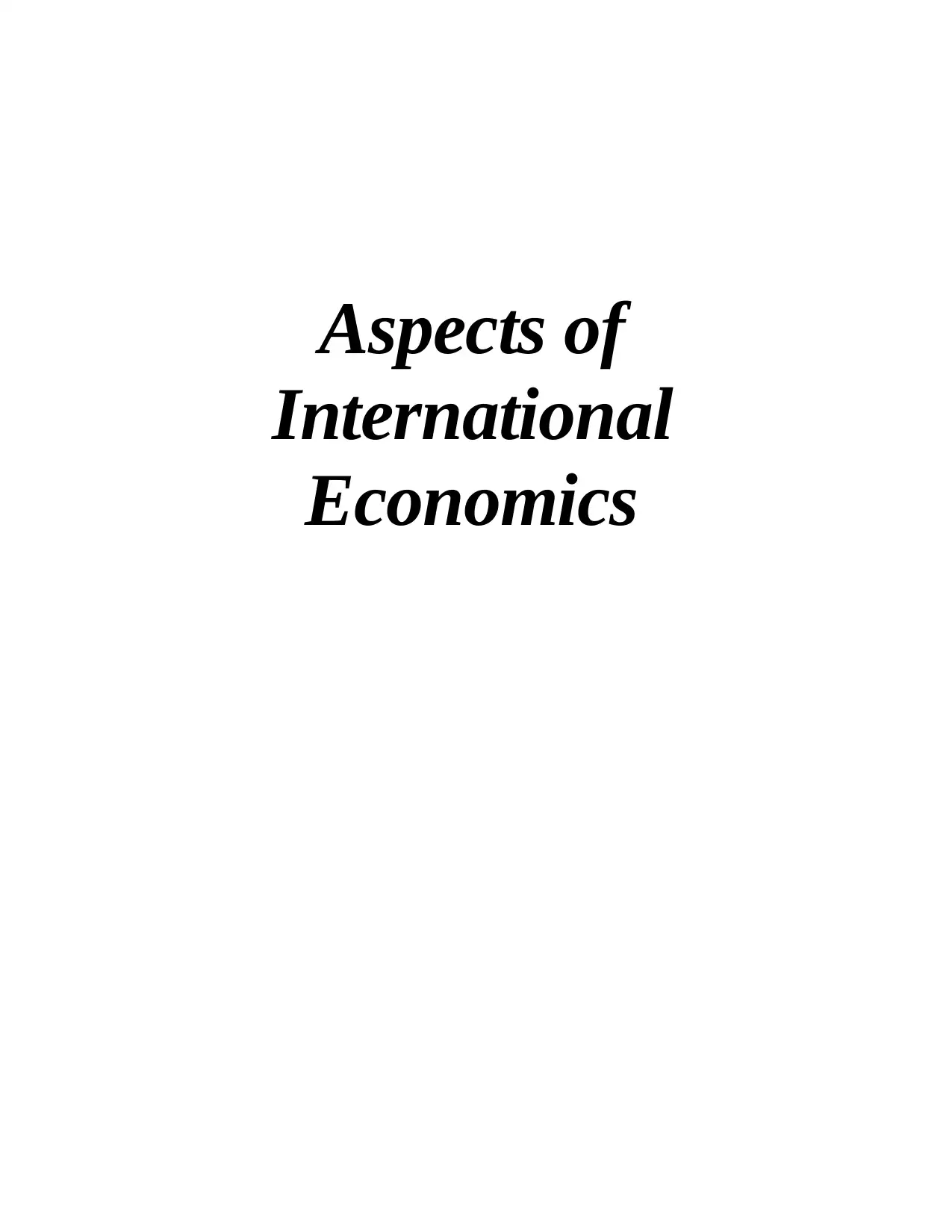
Aspects of
International
Economics
International
Economics
Paraphrase This Document
Need a fresh take? Get an instant paraphrase of this document with our AI Paraphraser
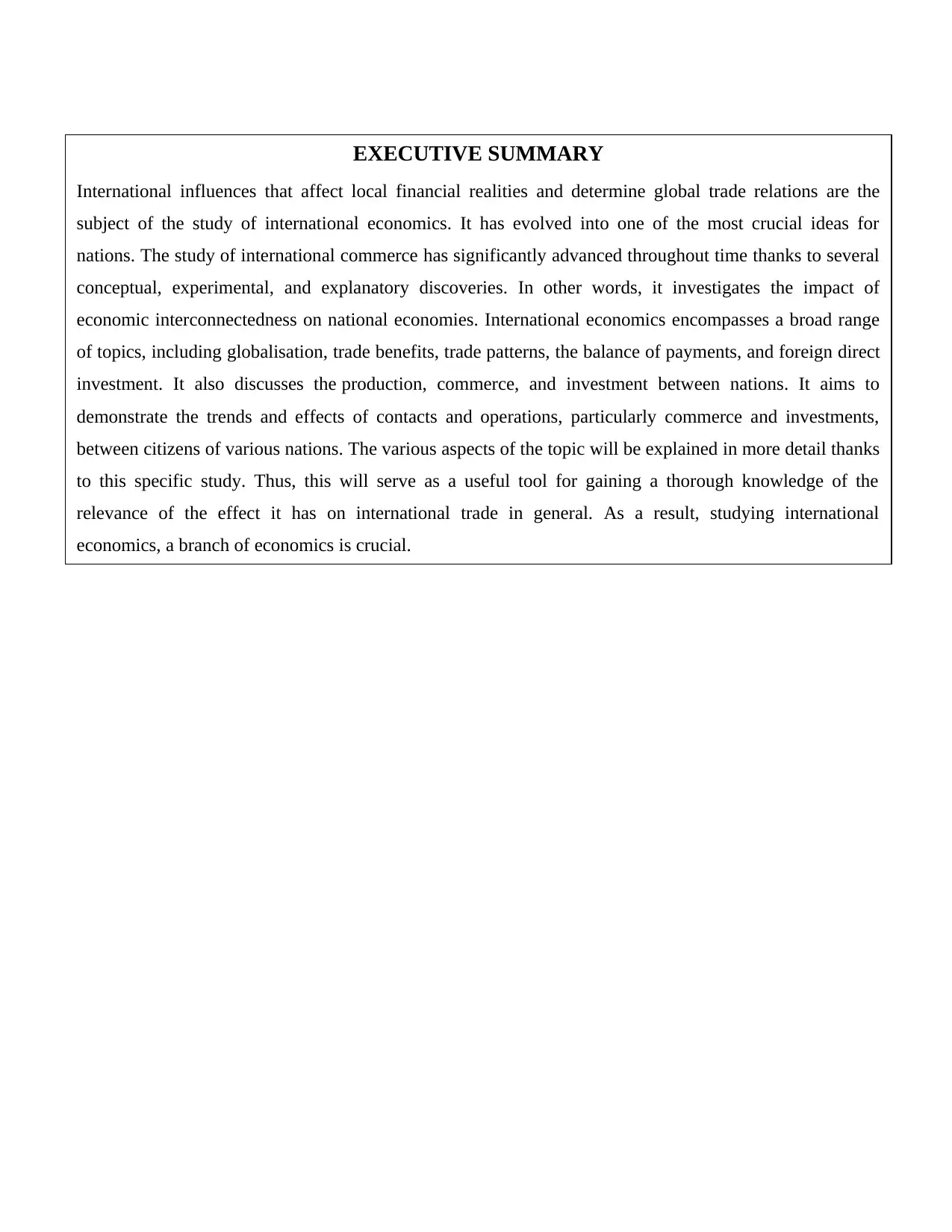
EXECUTIVE SUMMARY
International influences that affect local financial realities and determine global trade relations are the
subject of the study of international economics. It has evolved into one of the most crucial ideas for
nations. The study of international commerce has significantly advanced throughout time thanks to several
conceptual, experimental, and explanatory discoveries. In other words, it investigates the impact of
economic interconnectedness on national economies. International economics encompasses a broad range
of topics, including globalisation, trade benefits, trade patterns, the balance of payments, and foreign direct
investment. It also discusses the production, commerce, and investment between nations. It aims to
demonstrate the trends and effects of contacts and operations, particularly commerce and investments,
between citizens of various nations. The various aspects of the topic will be explained in more detail thanks
to this specific study. Thus, this will serve as a useful tool for gaining a thorough knowledge of the
relevance of the effect it has on international trade in general. As a result, studying international
economics, a branch of economics is crucial.
International influences that affect local financial realities and determine global trade relations are the
subject of the study of international economics. It has evolved into one of the most crucial ideas for
nations. The study of international commerce has significantly advanced throughout time thanks to several
conceptual, experimental, and explanatory discoveries. In other words, it investigates the impact of
economic interconnectedness on national economies. International economics encompasses a broad range
of topics, including globalisation, trade benefits, trade patterns, the balance of payments, and foreign direct
investment. It also discusses the production, commerce, and investment between nations. It aims to
demonstrate the trends and effects of contacts and operations, particularly commerce and investments,
between citizens of various nations. The various aspects of the topic will be explained in more detail thanks
to this specific study. Thus, this will serve as a useful tool for gaining a thorough knowledge of the
relevance of the effect it has on international trade in general. As a result, studying international
economics, a branch of economics is crucial.
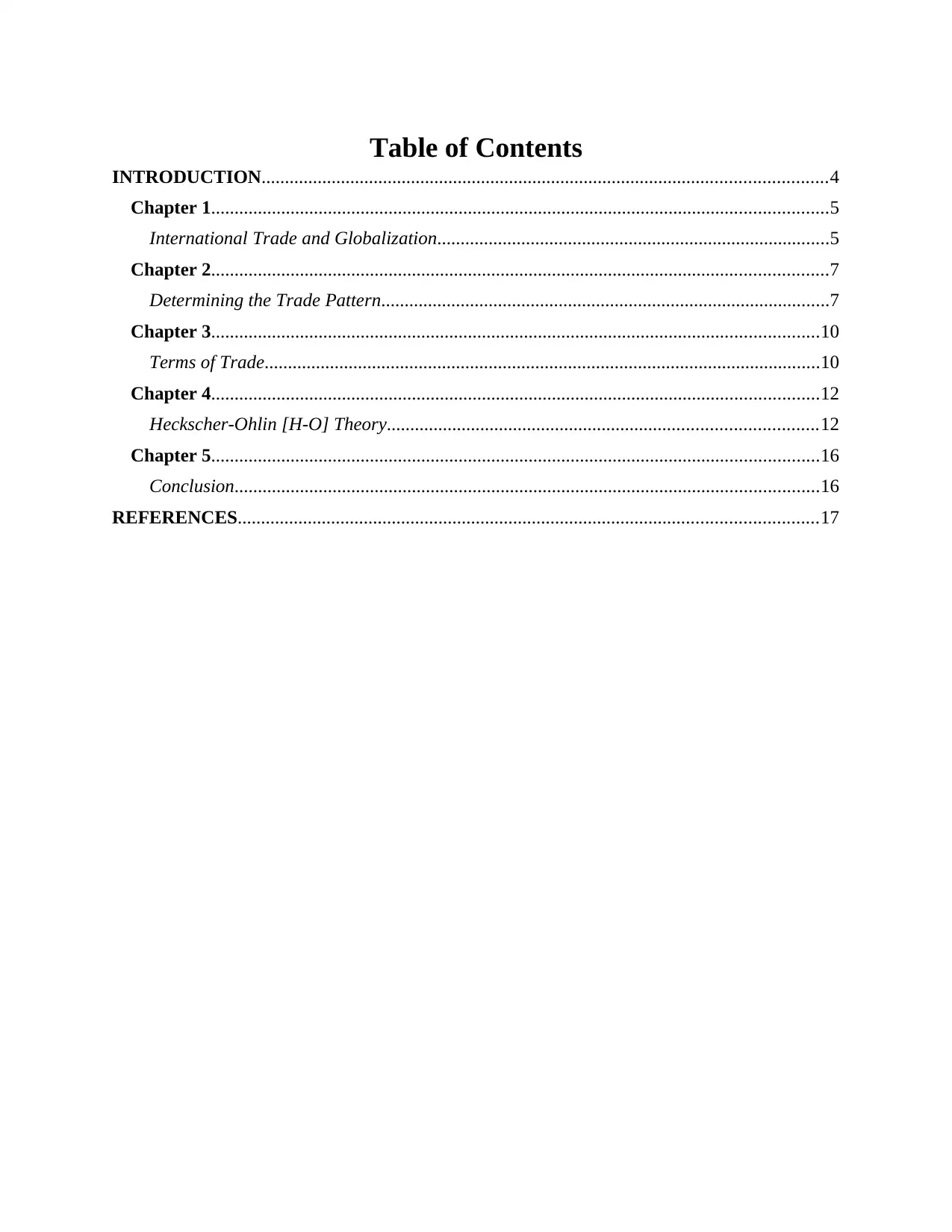
Table of Contents
INTRODUCTION.........................................................................................................................4
Chapter 1....................................................................................................................................5
International Trade and Globalization....................................................................................5
Chapter 2....................................................................................................................................7
Determining the Trade Pattern................................................................................................7
Chapter 3..................................................................................................................................10
Terms of Trade.......................................................................................................................10
Chapter 4..................................................................................................................................12
Heckscher-Ohlin [H-O] Theory............................................................................................12
Chapter 5..................................................................................................................................16
Conclusion.............................................................................................................................16
REFERENCES............................................................................................................................17
INTRODUCTION.........................................................................................................................4
Chapter 1....................................................................................................................................5
International Trade and Globalization....................................................................................5
Chapter 2....................................................................................................................................7
Determining the Trade Pattern................................................................................................7
Chapter 3..................................................................................................................................10
Terms of Trade.......................................................................................................................10
Chapter 4..................................................................................................................................12
Heckscher-Ohlin [H-O] Theory............................................................................................12
Chapter 5..................................................................................................................................16
Conclusion.............................................................................................................................16
REFERENCES............................................................................................................................17
⊘ This is a preview!⊘
Do you want full access?
Subscribe today to unlock all pages.

Trusted by 1+ million students worldwide
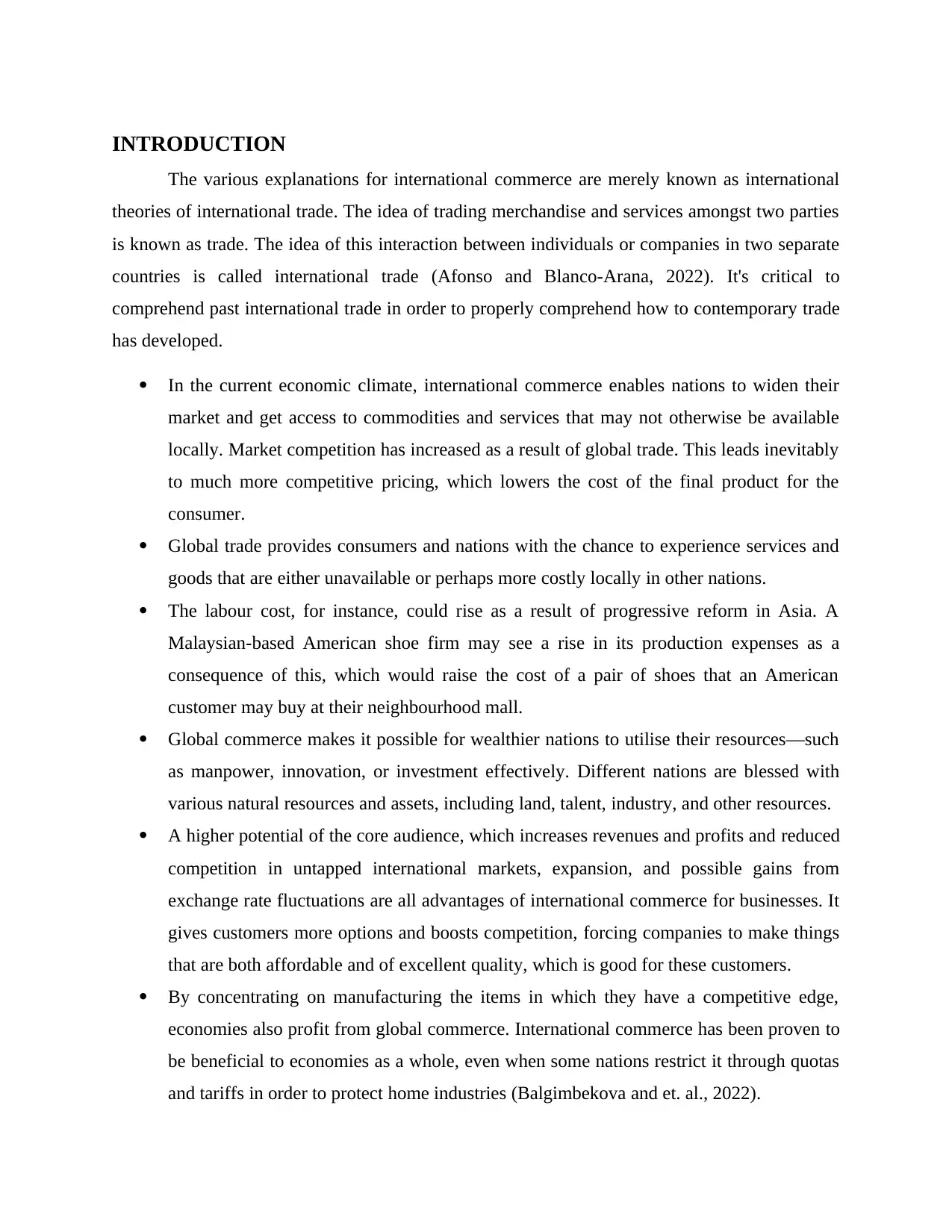
INTRODUCTION
The various explanations for international commerce are merely known as international
theories of international trade. The idea of trading merchandise and services amongst two parties
is known as trade. The idea of this interaction between individuals or companies in two separate
countries is called international trade (Afonso and Blanco-Arana, 2022). It's critical to
comprehend past international trade in order to properly comprehend how to contemporary trade
has developed.
In the current economic climate, international commerce enables nations to widen their
market and get access to commodities and services that may not otherwise be available
locally. Market competition has increased as a result of global trade. This leads inevitably
to much more competitive pricing, which lowers the cost of the final product for the
consumer.
Global trade provides consumers and nations with the chance to experience services and
goods that are either unavailable or perhaps more costly locally in other nations.
The labour cost, for instance, could rise as a result of progressive reform in Asia. A
Malaysian-based American shoe firm may see a rise in its production expenses as a
consequence of this, which would raise the cost of a pair of shoes that an American
customer may buy at their neighbourhood mall.
Global commerce makes it possible for wealthier nations to utilise their resources—such
as manpower, innovation, or investment effectively. Different nations are blessed with
various natural resources and assets, including land, talent, industry, and other resources.
A higher potential of the core audience, which increases revenues and profits and reduced
competition in untapped international markets, expansion, and possible gains from
exchange rate fluctuations are all advantages of international commerce for businesses. It
gives customers more options and boosts competition, forcing companies to make things
that are both affordable and of excellent quality, which is good for these customers.
By concentrating on manufacturing the items in which they have a competitive edge,
economies also profit from global commerce. International commerce has been proven to
be beneficial to economies as a whole, even when some nations restrict it through quotas
and tariffs in order to protect home industries (Balgimbekova and et. al., 2022).
The various explanations for international commerce are merely known as international
theories of international trade. The idea of trading merchandise and services amongst two parties
is known as trade. The idea of this interaction between individuals or companies in two separate
countries is called international trade (Afonso and Blanco-Arana, 2022). It's critical to
comprehend past international trade in order to properly comprehend how to contemporary trade
has developed.
In the current economic climate, international commerce enables nations to widen their
market and get access to commodities and services that may not otherwise be available
locally. Market competition has increased as a result of global trade. This leads inevitably
to much more competitive pricing, which lowers the cost of the final product for the
consumer.
Global trade provides consumers and nations with the chance to experience services and
goods that are either unavailable or perhaps more costly locally in other nations.
The labour cost, for instance, could rise as a result of progressive reform in Asia. A
Malaysian-based American shoe firm may see a rise in its production expenses as a
consequence of this, which would raise the cost of a pair of shoes that an American
customer may buy at their neighbourhood mall.
Global commerce makes it possible for wealthier nations to utilise their resources—such
as manpower, innovation, or investment effectively. Different nations are blessed with
various natural resources and assets, including land, talent, industry, and other resources.
A higher potential of the core audience, which increases revenues and profits and reduced
competition in untapped international markets, expansion, and possible gains from
exchange rate fluctuations are all advantages of international commerce for businesses. It
gives customers more options and boosts competition, forcing companies to make things
that are both affordable and of excellent quality, which is good for these customers.
By concentrating on manufacturing the items in which they have a competitive edge,
economies also profit from global commerce. International commerce has been proven to
be beneficial to economies as a whole, even when some nations restrict it through quotas
and tariffs in order to protect home industries (Balgimbekova and et. al., 2022).
Paraphrase This Document
Need a fresh take? Get an instant paraphrase of this document with our AI Paraphraser
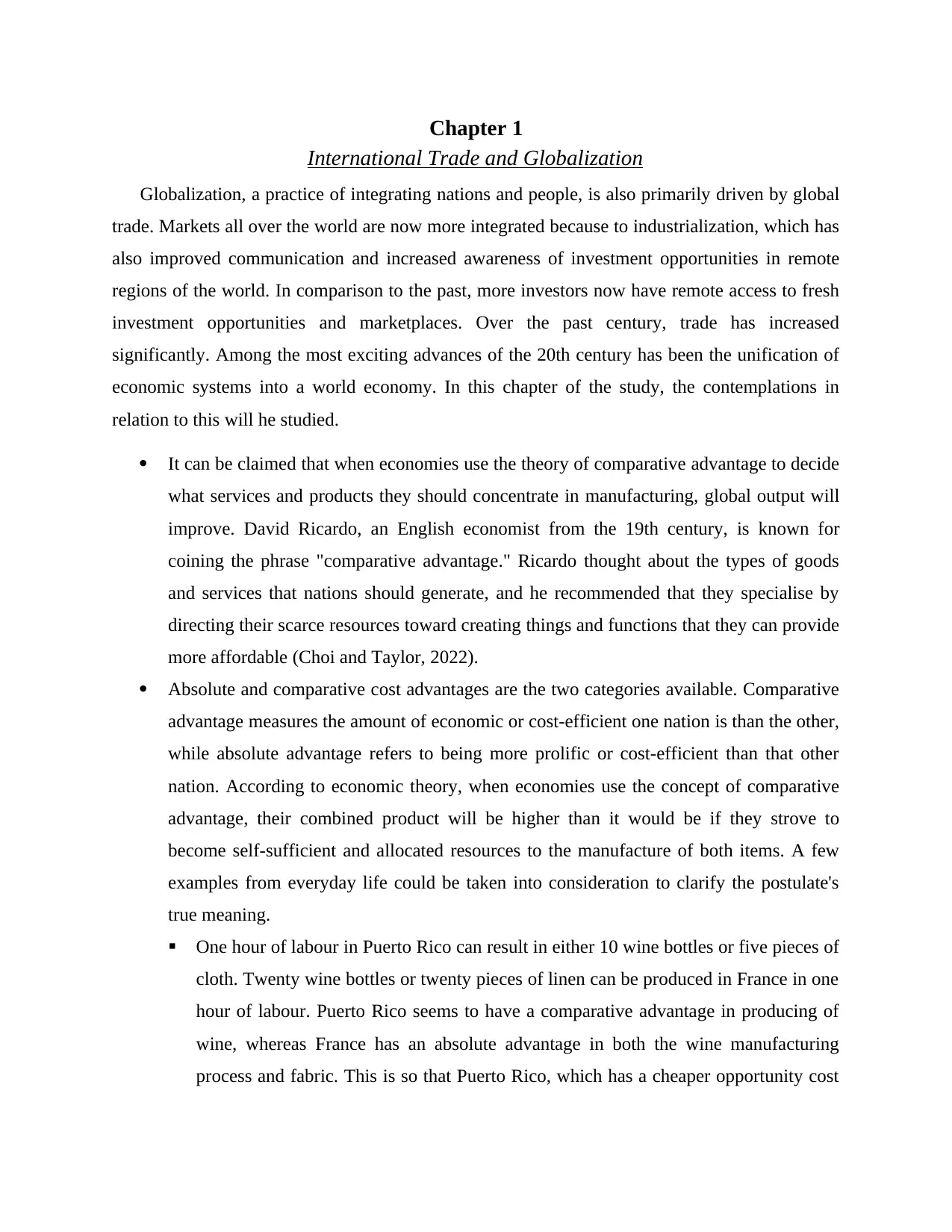
Chapter 1
International Trade and Globalization
Globalization, a practice of integrating nations and people, is also primarily driven by global
trade. Markets all over the world are now more integrated because to industrialization, which has
also improved communication and increased awareness of investment opportunities in remote
regions of the world. In comparison to the past, more investors now have remote access to fresh
investment opportunities and marketplaces. Over the past century, trade has increased
significantly. Among the most exciting advances of the 20th century has been the unification of
economic systems into a world economy. In this chapter of the study, the contemplations in
relation to this will he studied.
It can be claimed that when economies use the theory of comparative advantage to decide
what services and products they should concentrate in manufacturing, global output will
improve. David Ricardo, an English economist from the 19th century, is known for
coining the phrase "comparative advantage." Ricardo thought about the types of goods
and services that nations should generate, and he recommended that they specialise by
directing their scarce resources toward creating things and functions that they can provide
more affordable (Choi and Taylor, 2022).
Absolute and comparative cost advantages are the two categories available. Comparative
advantage measures the amount of economic or cost-efficient one nation is than the other,
while absolute advantage refers to being more prolific or cost-efficient than that other
nation. According to economic theory, when economies use the concept of comparative
advantage, their combined product will be higher than it would be if they strove to
become self-sufficient and allocated resources to the manufacture of both items. A few
examples from everyday life could be taken into consideration to clarify the postulate's
true meaning.
One hour of labour in Puerto Rico can result in either 10 wine bottles or five pieces of
cloth. Twenty wine bottles or twenty pieces of linen can be produced in France in one
hour of labour. Puerto Rico seems to have a comparative advantage in producing of
wine, whereas France has an absolute advantage in both the wine manufacturing
process and fabric. This is so that Puerto Rico, which has a cheaper opportunity cost
International Trade and Globalization
Globalization, a practice of integrating nations and people, is also primarily driven by global
trade. Markets all over the world are now more integrated because to industrialization, which has
also improved communication and increased awareness of investment opportunities in remote
regions of the world. In comparison to the past, more investors now have remote access to fresh
investment opportunities and marketplaces. Over the past century, trade has increased
significantly. Among the most exciting advances of the 20th century has been the unification of
economic systems into a world economy. In this chapter of the study, the contemplations in
relation to this will he studied.
It can be claimed that when economies use the theory of comparative advantage to decide
what services and products they should concentrate in manufacturing, global output will
improve. David Ricardo, an English economist from the 19th century, is known for
coining the phrase "comparative advantage." Ricardo thought about the types of goods
and services that nations should generate, and he recommended that they specialise by
directing their scarce resources toward creating things and functions that they can provide
more affordable (Choi and Taylor, 2022).
Absolute and comparative cost advantages are the two categories available. Comparative
advantage measures the amount of economic or cost-efficient one nation is than the other,
while absolute advantage refers to being more prolific or cost-efficient than that other
nation. According to economic theory, when economies use the concept of comparative
advantage, their combined product will be higher than it would be if they strove to
become self-sufficient and allocated resources to the manufacture of both items. A few
examples from everyday life could be taken into consideration to clarify the postulate's
true meaning.
One hour of labour in Puerto Rico can result in either 10 wine bottles or five pieces of
cloth. Twenty wine bottles or twenty pieces of linen can be produced in France in one
hour of labour. Puerto Rico seems to have a comparative advantage in producing of
wine, whereas France has an absolute advantage in both the wine manufacturing
process and fabric. This is so that Puerto Rico, which has a cheaper opportunity cost
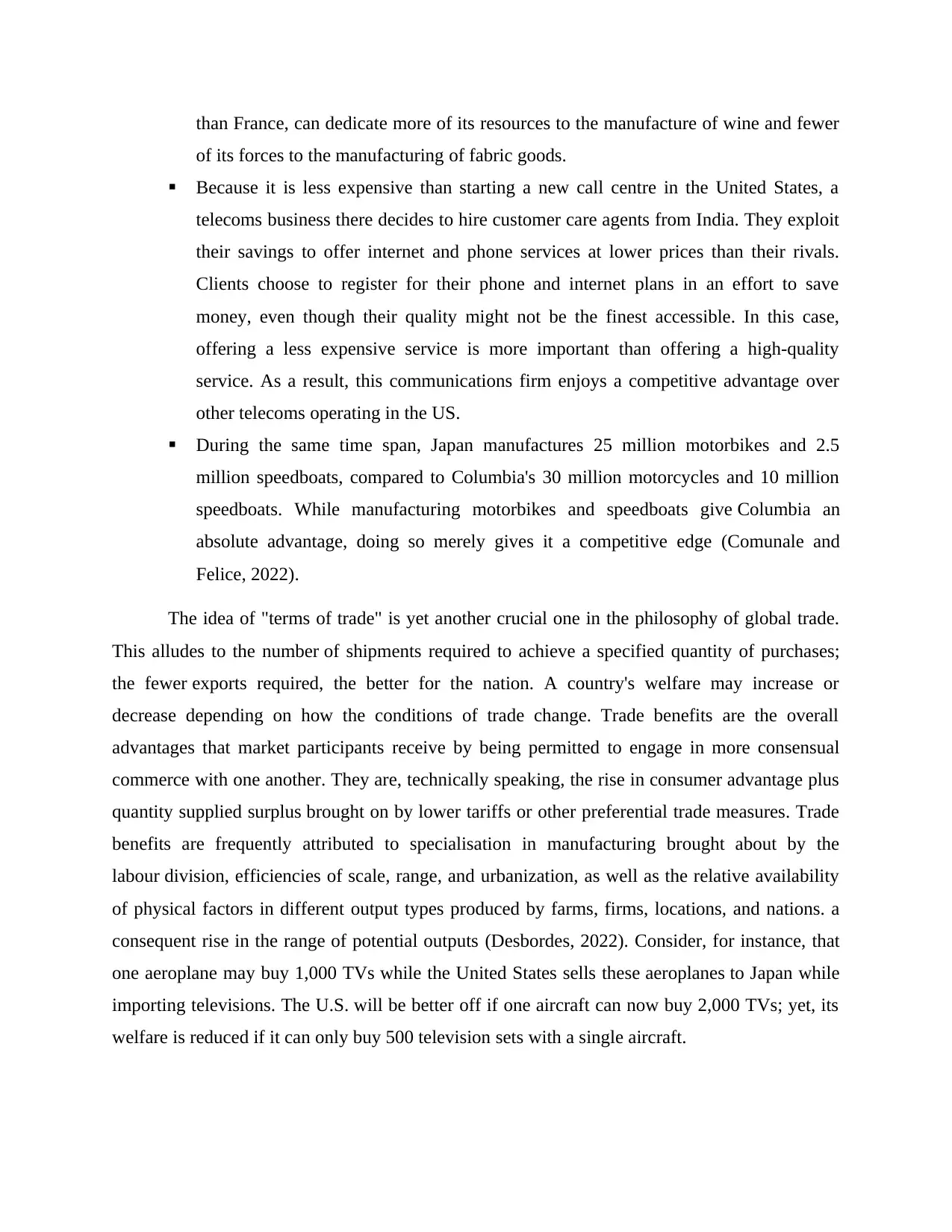
than France, can dedicate more of its resources to the manufacture of wine and fewer
of its forces to the manufacturing of fabric goods.
Because it is less expensive than starting a new call centre in the United States, a
telecoms business there decides to hire customer care agents from India. They exploit
their savings to offer internet and phone services at lower prices than their rivals.
Clients choose to register for their phone and internet plans in an effort to save
money, even though their quality might not be the finest accessible. In this case,
offering a less expensive service is more important than offering a high-quality
service. As a result, this communications firm enjoys a competitive advantage over
other telecoms operating in the US.
During the same time span, Japan manufactures 25 million motorbikes and 2.5
million speedboats, compared to Columbia's 30 million motorcycles and 10 million
speedboats. While manufacturing motorbikes and speedboats give Columbia an
absolute advantage, doing so merely gives it a competitive edge (Comunale and
Felice, 2022).
The idea of "terms of trade" is yet another crucial one in the philosophy of global trade.
This alludes to the number of shipments required to achieve a specified quantity of purchases;
the fewer exports required, the better for the nation. A country's welfare may increase or
decrease depending on how the conditions of trade change. Trade benefits are the overall
advantages that market participants receive by being permitted to engage in more consensual
commerce with one another. They are, technically speaking, the rise in consumer advantage plus
quantity supplied surplus brought on by lower tariffs or other preferential trade measures. Trade
benefits are frequently attributed to specialisation in manufacturing brought about by the
labour division, efficiencies of scale, range, and urbanization, as well as the relative availability
of physical factors in different output types produced by farms, firms, locations, and nations. a
consequent rise in the range of potential outputs (Desbordes, 2022). Consider, for instance, that
one aeroplane may buy 1,000 TVs while the United States sells these aeroplanes to Japan while
importing televisions. The U.S. will be better off if one aircraft can now buy 2,000 TVs; yet, its
welfare is reduced if it can only buy 500 television sets with a single aircraft.
of its forces to the manufacturing of fabric goods.
Because it is less expensive than starting a new call centre in the United States, a
telecoms business there decides to hire customer care agents from India. They exploit
their savings to offer internet and phone services at lower prices than their rivals.
Clients choose to register for their phone and internet plans in an effort to save
money, even though their quality might not be the finest accessible. In this case,
offering a less expensive service is more important than offering a high-quality
service. As a result, this communications firm enjoys a competitive advantage over
other telecoms operating in the US.
During the same time span, Japan manufactures 25 million motorbikes and 2.5
million speedboats, compared to Columbia's 30 million motorcycles and 10 million
speedboats. While manufacturing motorbikes and speedboats give Columbia an
absolute advantage, doing so merely gives it a competitive edge (Comunale and
Felice, 2022).
The idea of "terms of trade" is yet another crucial one in the philosophy of global trade.
This alludes to the number of shipments required to achieve a specified quantity of purchases;
the fewer exports required, the better for the nation. A country's welfare may increase or
decrease depending on how the conditions of trade change. Trade benefits are the overall
advantages that market participants receive by being permitted to engage in more consensual
commerce with one another. They are, technically speaking, the rise in consumer advantage plus
quantity supplied surplus brought on by lower tariffs or other preferential trade measures. Trade
benefits are frequently attributed to specialisation in manufacturing brought about by the
labour division, efficiencies of scale, range, and urbanization, as well as the relative availability
of physical factors in different output types produced by farms, firms, locations, and nations. a
consequent rise in the range of potential outputs (Desbordes, 2022). Consider, for instance, that
one aeroplane may buy 1,000 TVs while the United States sells these aeroplanes to Japan while
importing televisions. The U.S. will be better off if one aircraft can now buy 2,000 TVs; yet, its
welfare is reduced if it can only buy 500 television sets with a single aircraft.
⊘ This is a preview!⊘
Do you want full access?
Subscribe today to unlock all pages.

Trusted by 1+ million students worldwide

Paraphrase This Document
Need a fresh take? Get an instant paraphrase of this document with our AI Paraphraser
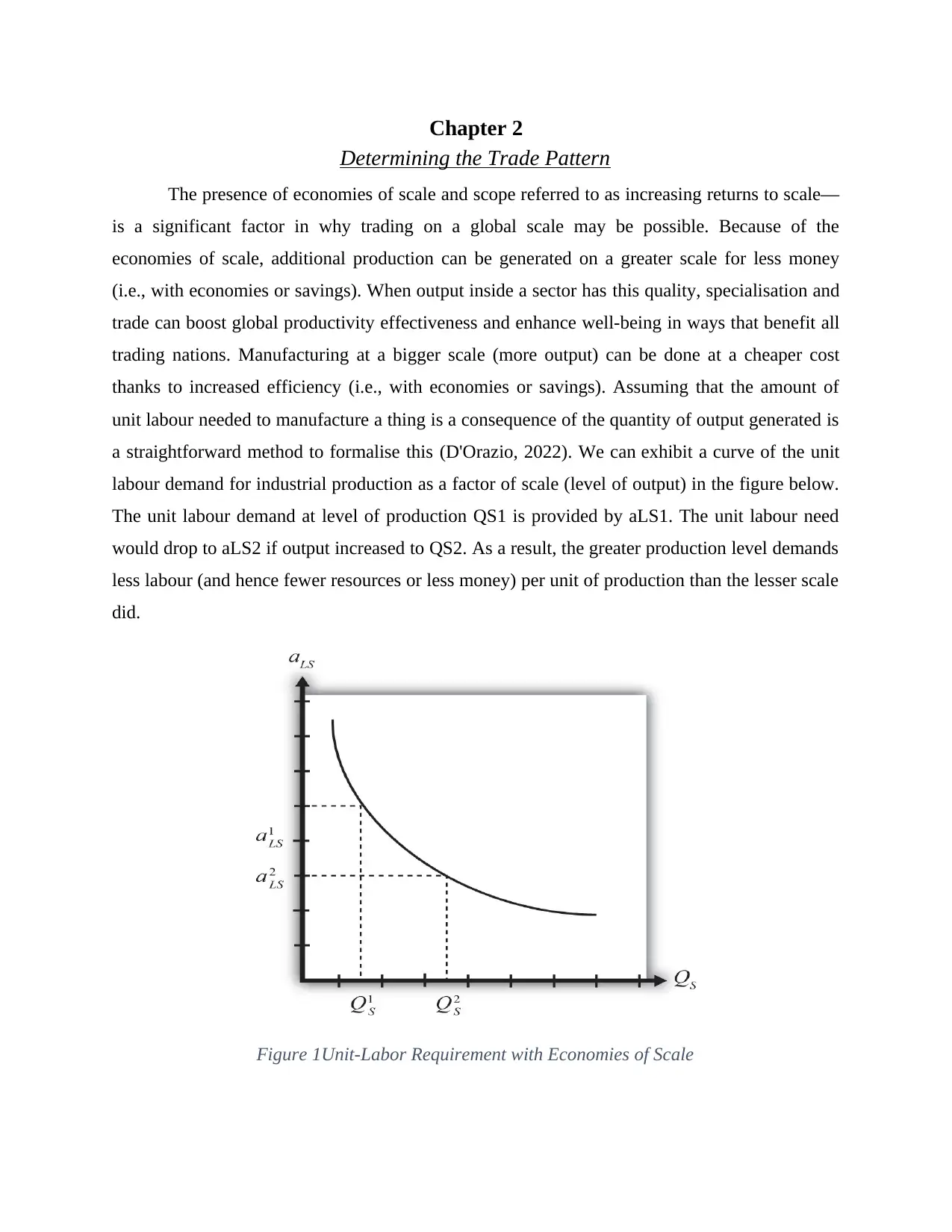
Chapter 2
Determining the Trade Pattern
The presence of economies of scale and scope referred to as increasing returns to scale—
is a significant factor in why trading on a global scale may be possible. Because of the
economies of scale, additional production can be generated on a greater scale for less money
(i.e., with economies or savings). When output inside a sector has this quality, specialisation and
trade can boost global productivity effectiveness and enhance well-being in ways that benefit all
trading nations. Manufacturing at a bigger scale (more output) can be done at a cheaper cost
thanks to increased efficiency (i.e., with economies or savings). Assuming that the amount of
unit labour needed to manufacture a thing is a consequence of the quantity of output generated is
a straightforward method to formalise this (D'Orazio, 2022). We can exhibit a curve of the unit
labour demand for industrial production as a factor of scale (level of output) in the figure below.
The unit labour demand at level of production QS1 is provided by aLS1. The unit labour need
would drop to aLS2 if output increased to QS2. As a result, the greater production level demands
less labour (and hence fewer resources or less money) per unit of production than the lesser scale
did.
Figure 1Unit-Labor Requirement with Economies of Scale
Determining the Trade Pattern
The presence of economies of scale and scope referred to as increasing returns to scale—
is a significant factor in why trading on a global scale may be possible. Because of the
economies of scale, additional production can be generated on a greater scale for less money
(i.e., with economies or savings). When output inside a sector has this quality, specialisation and
trade can boost global productivity effectiveness and enhance well-being in ways that benefit all
trading nations. Manufacturing at a bigger scale (more output) can be done at a cheaper cost
thanks to increased efficiency (i.e., with economies or savings). Assuming that the amount of
unit labour needed to manufacture a thing is a consequence of the quantity of output generated is
a straightforward method to formalise this (D'Orazio, 2022). We can exhibit a curve of the unit
labour demand for industrial production as a factor of scale (level of output) in the figure below.
The unit labour demand at level of production QS1 is provided by aLS1. The unit labour need
would drop to aLS2 if output increased to QS2. As a result, the greater production level demands
less labour (and hence fewer resources or less money) per unit of production than the lesser scale
did.
Figure 1Unit-Labor Requirement with Economies of Scale
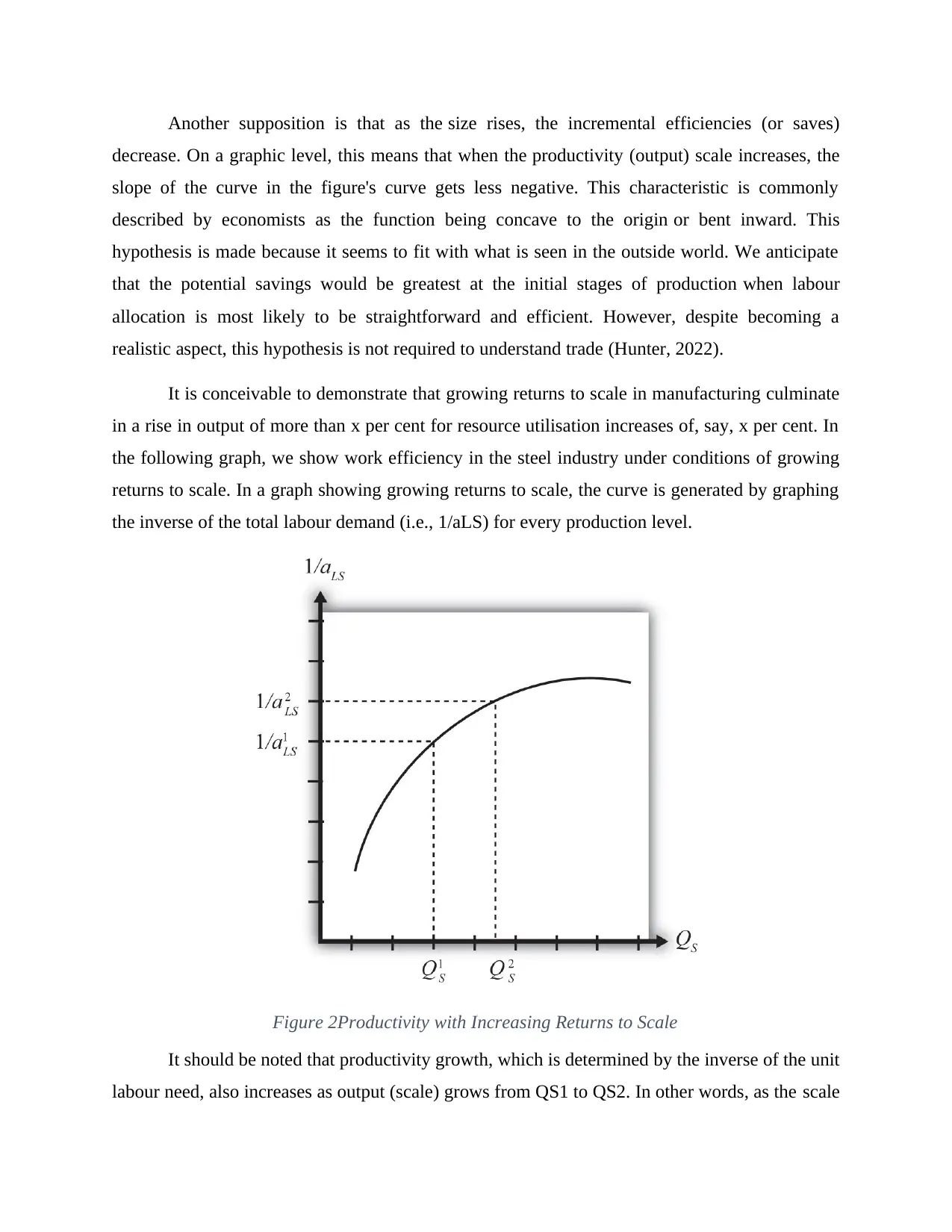
Another supposition is that as the size rises, the incremental efficiencies (or saves)
decrease. On a graphic level, this means that when the productivity (output) scale increases, the
slope of the curve in the figure's curve gets less negative. This characteristic is commonly
described by economists as the function being concave to the origin or bent inward. This
hypothesis is made because it seems to fit with what is seen in the outside world. We anticipate
that the potential savings would be greatest at the initial stages of production when labour
allocation is most likely to be straightforward and efficient. However, despite becoming a
realistic aspect, this hypothesis is not required to understand trade (Hunter, 2022).
It is conceivable to demonstrate that growing returns to scale in manufacturing culminate
in a rise in output of more than x per cent for resource utilisation increases of, say, x per cent. In
the following graph, we show work efficiency in the steel industry under conditions of growing
returns to scale. In a graph showing growing returns to scale, the curve is generated by graphing
the inverse of the total labour demand (i.e., 1/aLS) for every production level.
Figure 2Productivity with Increasing Returns to Scale
It should be noted that productivity growth, which is determined by the inverse of the unit
labour need, also increases as output (scale) grows from QS1 to QS2. In other words, as the scale
decrease. On a graphic level, this means that when the productivity (output) scale increases, the
slope of the curve in the figure's curve gets less negative. This characteristic is commonly
described by economists as the function being concave to the origin or bent inward. This
hypothesis is made because it seems to fit with what is seen in the outside world. We anticipate
that the potential savings would be greatest at the initial stages of production when labour
allocation is most likely to be straightforward and efficient. However, despite becoming a
realistic aspect, this hypothesis is not required to understand trade (Hunter, 2022).
It is conceivable to demonstrate that growing returns to scale in manufacturing culminate
in a rise in output of more than x per cent for resource utilisation increases of, say, x per cent. In
the following graph, we show work efficiency in the steel industry under conditions of growing
returns to scale. In a graph showing growing returns to scale, the curve is generated by graphing
the inverse of the total labour demand (i.e., 1/aLS) for every production level.
Figure 2Productivity with Increasing Returns to Scale
It should be noted that productivity growth, which is determined by the inverse of the unit
labour need, also increases as output (scale) grows from QS1 to QS2. In other words, as the scale
⊘ This is a preview!⊘
Do you want full access?
Subscribe today to unlock all pages.

Trusted by 1+ million students worldwide
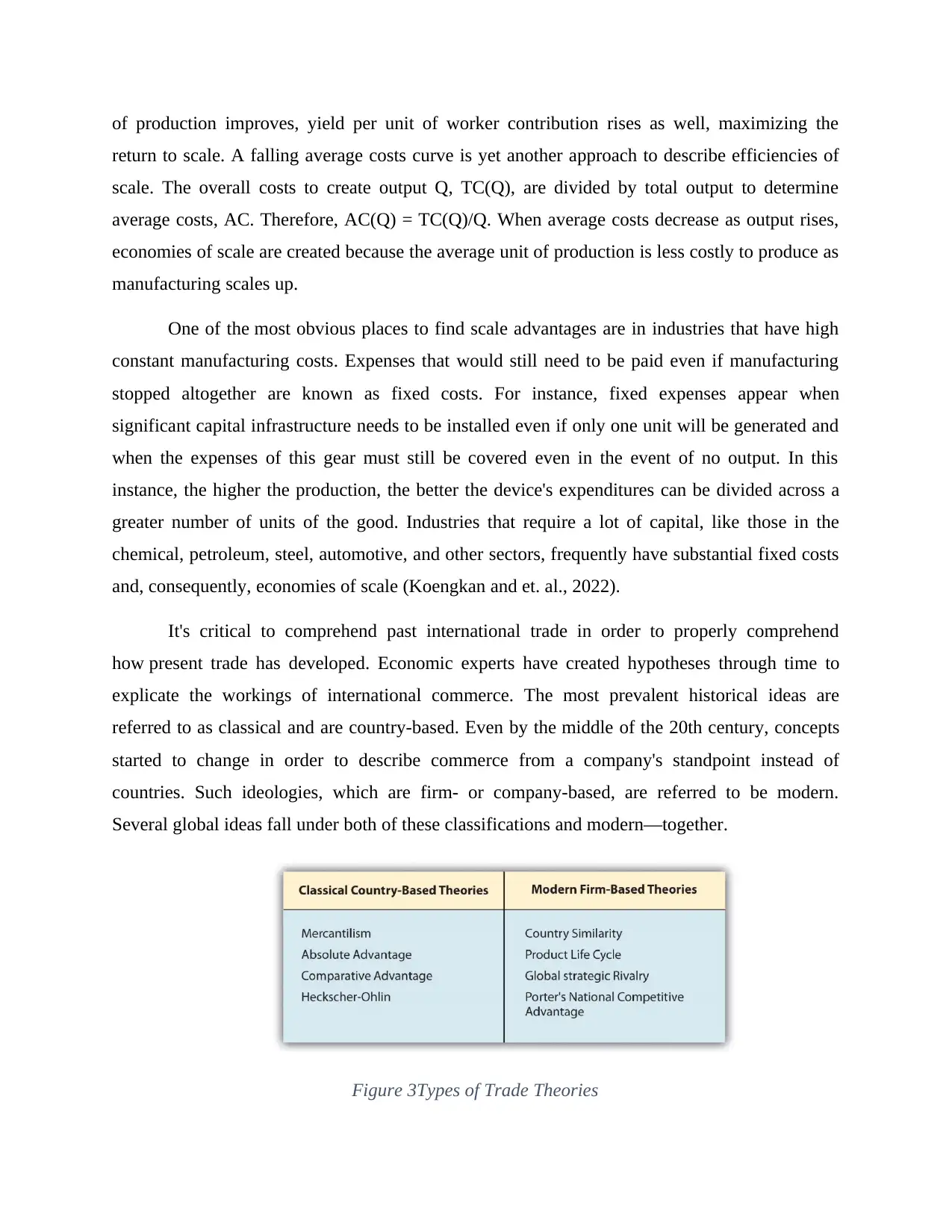
of production improves, yield per unit of worker contribution rises as well, maximizing the
return to scale. A falling average costs curve is yet another approach to describe efficiencies of
scale. The overall costs to create output Q, TC(Q), are divided by total output to determine
average costs, AC. Therefore, AC(Q) = TC(Q)/Q. When average costs decrease as output rises,
economies of scale are created because the average unit of production is less costly to produce as
manufacturing scales up.
One of the most obvious places to find scale advantages are in industries that have high
constant manufacturing costs. Expenses that would still need to be paid even if manufacturing
stopped altogether are known as fixed costs. For instance, fixed expenses appear when
significant capital infrastructure needs to be installed even if only one unit will be generated and
when the expenses of this gear must still be covered even in the event of no output. In this
instance, the higher the production, the better the device's expenditures can be divided across a
greater number of units of the good. Industries that require a lot of capital, like those in the
chemical, petroleum, steel, automotive, and other sectors, frequently have substantial fixed costs
and, consequently, economies of scale (Koengkan and et. al., 2022).
It's critical to comprehend past international trade in order to properly comprehend
how present trade has developed. Economic experts have created hypotheses through time to
explicate the workings of international commerce. The most prevalent historical ideas are
referred to as classical and are country-based. Even by the middle of the 20th century, concepts
started to change in order to describe commerce from a company's standpoint instead of
countries. Such ideologies, which are firm- or company-based, are referred to be modern.
Several global ideas fall under both of these classifications and modern—together.
Figure 3Types of Trade Theories
return to scale. A falling average costs curve is yet another approach to describe efficiencies of
scale. The overall costs to create output Q, TC(Q), are divided by total output to determine
average costs, AC. Therefore, AC(Q) = TC(Q)/Q. When average costs decrease as output rises,
economies of scale are created because the average unit of production is less costly to produce as
manufacturing scales up.
One of the most obvious places to find scale advantages are in industries that have high
constant manufacturing costs. Expenses that would still need to be paid even if manufacturing
stopped altogether are known as fixed costs. For instance, fixed expenses appear when
significant capital infrastructure needs to be installed even if only one unit will be generated and
when the expenses of this gear must still be covered even in the event of no output. In this
instance, the higher the production, the better the device's expenditures can be divided across a
greater number of units of the good. Industries that require a lot of capital, like those in the
chemical, petroleum, steel, automotive, and other sectors, frequently have substantial fixed costs
and, consequently, economies of scale (Koengkan and et. al., 2022).
It's critical to comprehend past international trade in order to properly comprehend
how present trade has developed. Economic experts have created hypotheses through time to
explicate the workings of international commerce. The most prevalent historical ideas are
referred to as classical and are country-based. Even by the middle of the 20th century, concepts
started to change in order to describe commerce from a company's standpoint instead of
countries. Such ideologies, which are firm- or company-based, are referred to be modern.
Several global ideas fall under both of these classifications and modern—together.
Figure 3Types of Trade Theories
Paraphrase This Document
Need a fresh take? Get an instant paraphrase of this document with our AI Paraphraser
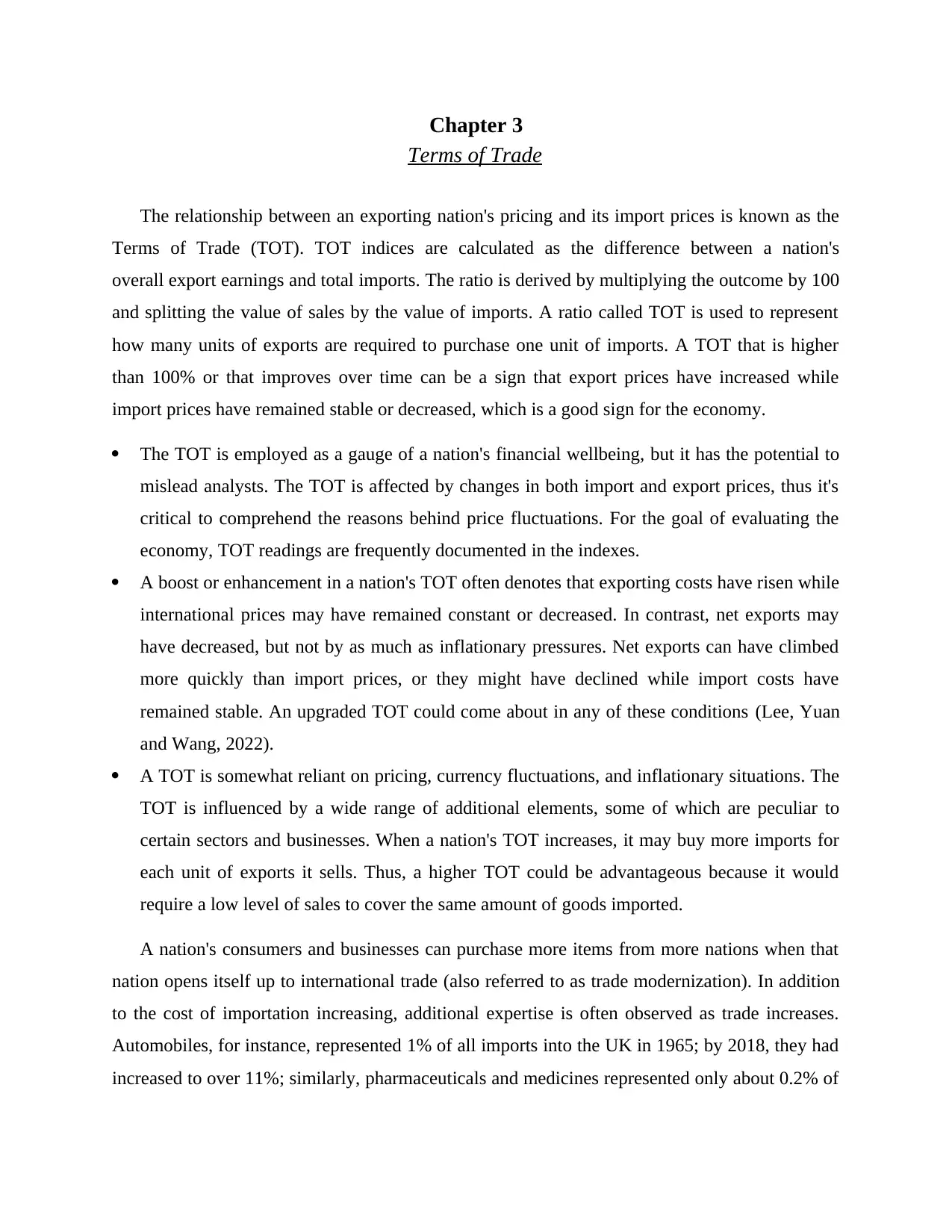
Chapter 3
Terms of Trade
The relationship between an exporting nation's pricing and its import prices is known as the
Terms of Trade (TOT). TOT indices are calculated as the difference between a nation's
overall export earnings and total imports. The ratio is derived by multiplying the outcome by 100
and splitting the value of sales by the value of imports. A ratio called TOT is used to represent
how many units of exports are required to purchase one unit of imports. A TOT that is higher
than 100% or that improves over time can be a sign that export prices have increased while
import prices have remained stable or decreased, which is a good sign for the economy.
The TOT is employed as a gauge of a nation's financial wellbeing, but it has the potential to
mislead analysts. The TOT is affected by changes in both import and export prices, thus it's
critical to comprehend the reasons behind price fluctuations. For the goal of evaluating the
economy, TOT readings are frequently documented in the indexes.
A boost or enhancement in a nation's TOT often denotes that exporting costs have risen while
international prices may have remained constant or decreased. In contrast, net exports may
have decreased, but not by as much as inflationary pressures. Net exports can have climbed
more quickly than import prices, or they might have declined while import costs have
remained stable. An upgraded TOT could come about in any of these conditions (Lee, Yuan
and Wang, 2022).
A TOT is somewhat reliant on pricing, currency fluctuations, and inflationary situations. The
TOT is influenced by a wide range of additional elements, some of which are peculiar to
certain sectors and businesses. When a nation's TOT increases, it may buy more imports for
each unit of exports it sells. Thus, a higher TOT could be advantageous because it would
require a low level of sales to cover the same amount of goods imported.
A nation's consumers and businesses can purchase more items from more nations when that
nation opens itself up to international trade (also referred to as trade modernization). In addition
to the cost of importation increasing, additional expertise is often observed as trade increases.
Automobiles, for instance, represented 1% of all imports into the UK in 1965; by 2018, they had
increased to over 11%; similarly, pharmaceuticals and medicines represented only about 0.2% of
Terms of Trade
The relationship between an exporting nation's pricing and its import prices is known as the
Terms of Trade (TOT). TOT indices are calculated as the difference between a nation's
overall export earnings and total imports. The ratio is derived by multiplying the outcome by 100
and splitting the value of sales by the value of imports. A ratio called TOT is used to represent
how many units of exports are required to purchase one unit of imports. A TOT that is higher
than 100% or that improves over time can be a sign that export prices have increased while
import prices have remained stable or decreased, which is a good sign for the economy.
The TOT is employed as a gauge of a nation's financial wellbeing, but it has the potential to
mislead analysts. The TOT is affected by changes in both import and export prices, thus it's
critical to comprehend the reasons behind price fluctuations. For the goal of evaluating the
economy, TOT readings are frequently documented in the indexes.
A boost or enhancement in a nation's TOT often denotes that exporting costs have risen while
international prices may have remained constant or decreased. In contrast, net exports may
have decreased, but not by as much as inflationary pressures. Net exports can have climbed
more quickly than import prices, or they might have declined while import costs have
remained stable. An upgraded TOT could come about in any of these conditions (Lee, Yuan
and Wang, 2022).
A TOT is somewhat reliant on pricing, currency fluctuations, and inflationary situations. The
TOT is influenced by a wide range of additional elements, some of which are peculiar to
certain sectors and businesses. When a nation's TOT increases, it may buy more imports for
each unit of exports it sells. Thus, a higher TOT could be advantageous because it would
require a low level of sales to cover the same amount of goods imported.
A nation's consumers and businesses can purchase more items from more nations when that
nation opens itself up to international trade (also referred to as trade modernization). In addition
to the cost of importation increasing, additional expertise is often observed as trade increases.
Automobiles, for instance, represented 1% of all imports into the UK in 1965; by 2018, they had
increased to over 11%; similarly, pharmaceuticals and medicines represented only about 0.2% of
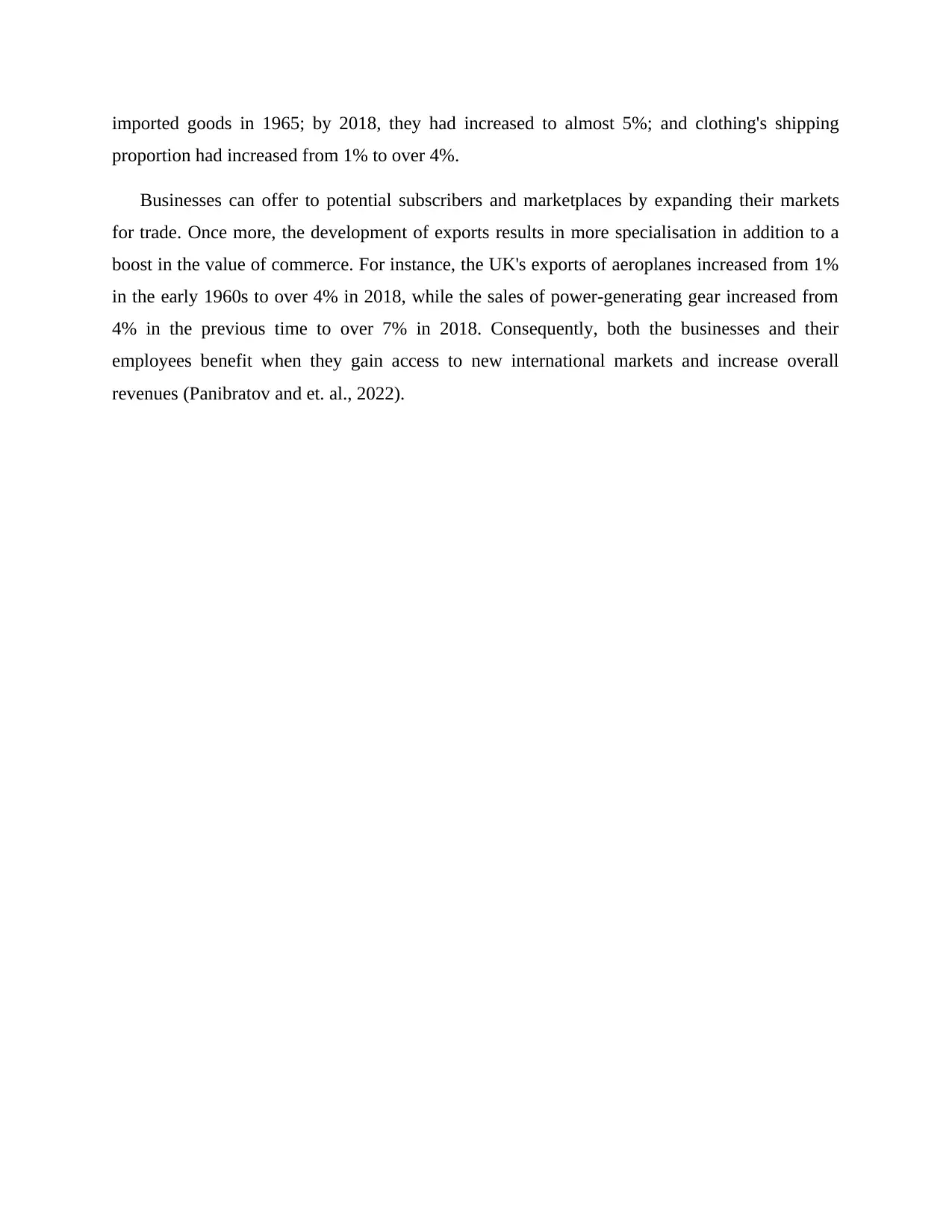
imported goods in 1965; by 2018, they had increased to almost 5%; and clothing's shipping
proportion had increased from 1% to over 4%.
Businesses can offer to potential subscribers and marketplaces by expanding their markets
for trade. Once more, the development of exports results in more specialisation in addition to a
boost in the value of commerce. For instance, the UK's exports of aeroplanes increased from 1%
in the early 1960s to over 4% in 2018, while the sales of power-generating gear increased from
4% in the previous time to over 7% in 2018. Consequently, both the businesses and their
employees benefit when they gain access to new international markets and increase overall
revenues (Panibratov and et. al., 2022).
proportion had increased from 1% to over 4%.
Businesses can offer to potential subscribers and marketplaces by expanding their markets
for trade. Once more, the development of exports results in more specialisation in addition to a
boost in the value of commerce. For instance, the UK's exports of aeroplanes increased from 1%
in the early 1960s to over 4% in 2018, while the sales of power-generating gear increased from
4% in the previous time to over 7% in 2018. Consequently, both the businesses and their
employees benefit when they gain access to new international markets and increase overall
revenues (Panibratov and et. al., 2022).
⊘ This is a preview!⊘
Do you want full access?
Subscribe today to unlock all pages.

Trusted by 1+ million students worldwide
1 out of 18
Related Documents
Your All-in-One AI-Powered Toolkit for Academic Success.
+13062052269
info@desklib.com
Available 24*7 on WhatsApp / Email
![[object Object]](/_next/static/media/star-bottom.7253800d.svg)
Unlock your academic potential
Copyright © 2020–2025 A2Z Services. All Rights Reserved. Developed and managed by ZUCOL.


